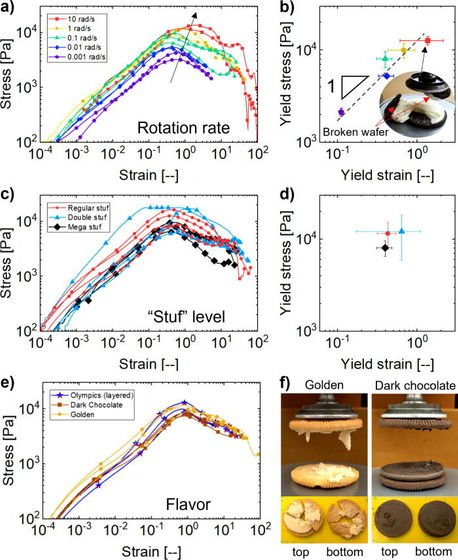Why does Oreo's cream stick to the cookie on one side only? Birth of 'Rheology'

Nabisco's '
On Oreology, the fracture and flow of “milk's favorite cookie®”: Physics of Fluids: Vol 34, No 4
https://aip.scitation.org/doi/10.1063/5.0085362
MIT engineers introduce the Oreometer | MIT News | Massachusetts Institute of Technology
https://news.mit.edu/2022/oreometer-cream-0419
“Oreology” investigates mystery of why Oreo creme filling usually sticks to one side | Ars Technica
https://arstechnica.com/science/2022/04/oreology-investigates-mystery-of-why-oreo-creme-filling-usually-sticks-to-one-side/
A wide range of fluid dynamics studies have been conducted on everyday foods such as mayonnaise and honey, for example the ' teapot effect ' where water drips from the spout of a squirt or teapot and the largest nut in a mixed nut bag. The 'Brazilian nut effect' that comes above is clarified by fluid mechanics.
Why does the phenomenon that the largest nut in a bag of mixed nuts comes up? --GIGAZINE

Among the fluid mechanics related to such foods, 'Oreo' was the subject of research by MIT's Crystal Owens and others. Owens et al. Focused on the phenomenon that the amount of cream adhered when twisting Oreo into two parts was biased, and applied torque to the object to measure the viscosity, using a device called ' Rheometer ' to measure the cream of Oreo. And named the series of studies Oreoology from Oreo + Rheology (fluidology) .
Aside from the fact that Mr. Owens loved Oreo from an early age, his research on Oreo's cream is the best example of 'a complex of plastic solids sandwiched between two parallel plates.' In other words, this research will lead to research on thermoplastic composite materials .
So, Owens and his colleagues bought various flavors at a local grocery store and started an experiment to split the oreo by twisting it with a leometer.

As a result of this experiment, it was found that the split state of the cream had nothing to do with the speed of twisting, the amount of cream, and the taste of cream. This bond level is probably related only to the level of adhesion that exists between the cookie and the cream, as Oreo in the same package was more likely to have the cream stick to the cookie in the same orientation. It was thought that it would be affected by the orientation of the cookie and the storage method.

In addition, the rate at which the cookie breaks at the time of splitting is greatly affected by the flavor of the cookie and the speed of twisting, so if you want to split the oleo without breaking the cookie, it is better to twist it slowly.
In this experiment, the cross section of the cream is the '
Owens and colleagues have also developed an 'Oreometer' that enables hydrodynamic research of Oreo without the need for a leometer as used in the laboratory.
The Oreo Twister / Oreometer-YouTube
The oleometer is an oleo-dedicated divider that can be created with a 3D printer. To use it, set the Oreo on the fixed part ...

Place the fixing part on the pedestal.

Connect the cylinder to the side of the fixing part. A coin is put in one side of this cylinder and weighted, but a rubber band is built in the fixed part, and the structure that converts the weight of the coin into a twisting force.

According to Owens et al.'S verification, the oleometer can obtain almost the same experimental results as the oleometer.
Blueprints and manuals for 3D printers of oleometers are distributed below.
On Oreology, the fracture and flow of “milk's favorite cookie®”: Physics of Fluids: Vol 34, No 4
https://aip.scitation.org/doi/suppl/10.1063/5.0085362
Related Posts:







